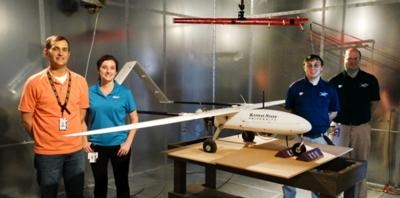Fri, Apr 17, 2015
Goal Is To Minimize Risk Of UAV Operations In The NAS
Two Kansas universities are working together with the FAA to minimize the risk associated with the operation of unmanned aerial systems (UAS) operating in the National Airspace System.

Recently Wichita State University's National Institute for Aviation Research (NIAR) and the Kansas State University Applied Aviation Research Center on the Salina campus conducted radiated susceptibility testing on a gasoline-powered, fixed-wing aircraft weighing 50 pounds with an 11-foot wingspan in a reverberation chamber at NIAR.
The radiated susceptibility testing was conducted to determine whether the aircraft's electronic systems will operate as intended when exposed to radio frequency, such as that emitted from broadcasting antennas and radio stations.
The tests are part of a larger effort by K-State Salina to validate the ASTM F38 Committee's standards for small unmanned aircraft systems.
"This partnership and subsequent research will achieve a broader understanding of the ASTM F38 requirements," said Tom Aldag, director of R&D for NIAR. "It will help us determine where the standard is overly restrictive and where there are gaps. The goal is to have a useful set of standards that benefits the UAS industry."
Wichita State is supporting K-State Salina in researching the environmental effects on UAS, especially in the areas of electromagnetic susceptibility, vibration and temperature variation. Together, they hope to achieve standardized test methods that the UAS industry can utilize in order to maintain public safety and well-being while benefiting from the wide range of applications and resources provided by UASs.
The project will conclude when required testing and evaluation has been completed and conclusions can be drawn about all applicable standards. The final project report will outline the project findings and include a gap analysis to show where the standards may have been insufficient to mitigate established operational risks. It will also include recommendations for changes to the standards that will close gaps where possible and allow for risk to be mitigated to a greater degree.
The tests were performed in NIAR's Environmental and Electromagnetic Test Labs, which will soon move to Air Capital Flight Line, formerly the site of the Boeing Company.
(Image provided by NIAR)
More News
“We have seen astounding demand for the G800, and the entire Gulfstream team is excited to begin making deliveries to our customers. The G800 is entering service with extraor>[...]
Aero Linx: Recreational Aviation Australia (RAAus) Recreational Aviation Australia is progressively working towards improving safety outcomes through a holistic approach to safety >[...]
Classic Klyde Morris From 11.07.16 (and Remembering Bob...) FMI: www.klydemorris.com>[...]
Also: GADFLY AI-Driven Engine Analysis, Knockoff Iranian Drones, Russian Surveillance, 40 NASA Missions Chopped This year’s Zenith Homecoming event will soon be taking off at>[...]
Also: H55 Completes American Tour, Robinson Trade-Ins, Retired AV-8B Harrier, NS-35 Mission Organizers of the iconic annual Air Race Classic will soon be opening registration for t>[...]
 Aero-News: Quote of the Day (08.28.25)
Aero-News: Quote of the Day (08.28.25) ANN's Daily Aero-Linx (08.28.25)
ANN's Daily Aero-Linx (08.28.25) Classic Klyde Morris (08.25.25)
Classic Klyde Morris (08.25.25) Airborne 08.25.25: Zenith Homecoming, VP Racing, Affordable Flying Expo 2025
Airborne 08.25.25: Zenith Homecoming, VP Racing, Affordable Flying Expo 2025 Airborne 08.22.25: ARC Spinoff, Nat'l Championship Air Races, Hawkins Accident
Airborne 08.22.25: ARC Spinoff, Nat'l Championship Air Races, Hawkins Accident



